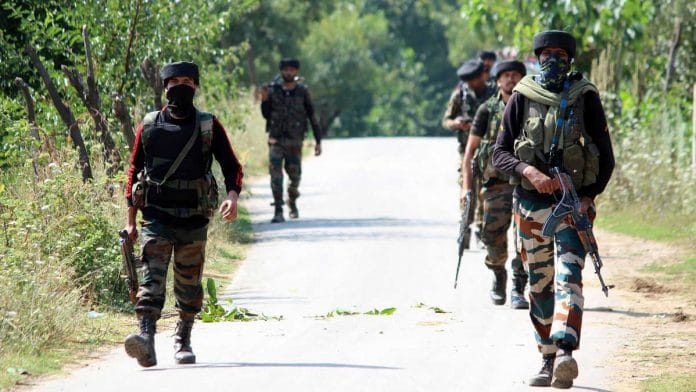New Delhi: Jammu and Kashmir saw across-the-board increase in militancy-related violence, including militants killed, caught, and attacks launched by militants, last year, according to data released by the Ministry of Home Affairs (MHA).
Compared to 2019, last year also witnessed an increase in exchanges of fire between militants and security forces, besides an uptick in the number of arms, including Improvised Explosive Devices (IEDs), seized, the data shows.
The spurt, however, needs to be seen in the context of the lull that followed the 2019 scrapping of Article 370 in J&K. There was a swift decline in operations against militants in the aftermath of 5 August 2019, when Article 370 was scrapped — a fact security forces attribute to the communication blackout that followed.
In the days before, security forces could intercept communication between militants as they relied on technology to talk to each other. In the absence of technology, militants began relying on word of mouth, officials say. As a result, the number of encounters decreased after August 2019 and the number of active militants increased in Kashmir. Last year, the blackout was lifted, and militants again began to use technology for communication.
The MHA data, accessed by ThePrint, states that 215 militants were killed in 2020, up 45 per cent over 2019, when 148 militants were killed. The year before, in 2018, 185 were killed. But, according to police data, number of militants killed each year remains somewhat similar — roughly 150-200.
Another 251 militants were arrested in 2020, an increase of 53 per cent over 2019, when 164 arrests were made. In 2018, the number of arrests was 184.
There were 111 instances in 2020 that involved exchanges of fire between militants and security forces, compared to 77 in 2019, an increase of 44 per cent. In 2018, the number of fire exchanges was 103 incidents.
The number of grenade attacks more than doubled — to 37 from 16 in 2019. The year before that, there were 27 attacks.
The MHA data says 360 arms were recovered from militants in 2020, compared to 192 in 2019, and 242 in 2018. The number of IEDs recovered rose to 41 from six in 2019, and that of detonators, to 117 from 19. In 2018, 18 IEDs were recovered as well as 142 detonators.
As many as eight militants surrendered last year, compared to zero in 2019 and 2018.
Last year also brought a fall of 80 per cent in the number of stone-pelting incidents — 93 stone-pelting incidents were reported in 2020, down from 477 in 2019, and 603 in 2018. However, government officials said this was primarily because of restrictions imposed in light of the Covid-19 pandemic.
Also Read: Communication blackout, offensive along Kashmir LoC — why Jammu is seeing militancy spike
‘Cycle of violence’
Talking about the data, a senior government official said there has been a rise in the number of arms, IEDs and detonators seized because of infiltrators bringing in weaponry from across the border.
“For example, even during the recent Nagrota encounter in November, massive ammunition and arms were recovered by the security forces,” the official said. “But largely, the trend is that more recoveries are being made now.”
Former CRPF Director General Durga Prasad said this was a result of “significant improvement” in intelligence gathering.
“The local police has a major role to play in terrorists being nabbed and ammunition being recovered,” he added.
The few cases of surrenders by militants, he said, are also an “encouraging and commendable trend”.
On the fall in the number of stone-pelting incidents, a government official cited the impact of the Covid-19 pandemic, which brought in strict social distancing norms that prevented large gatherings.
“Due to the pandemic, we stopped handing over the bodies of militants to their families. These were sites where tension would invariably brew, and incidents of stone-pelting and militant recruitment would take place,” the official said.
“However, due to Covid, we stopped returning the bodies. In some cases, we call the families of the militants, but in most cases, we don’t even do that, to avoid trouble,” the official added.
Speaking on the overall trend, Lt Gen. H.S. Panag (Retd) said the “number of explosives recovered or the number of increase in attacks is part of the cycle of an ongoing insurgency”.
“These are part of the routine cycle of violence,” he added. “The fundamental point is that a political solution to the insurgency is still elusive, and these numbers will keep going up and down until that happens.”
The MHA data comes on the heels of J&K Police estimates that showed 167 youths from Kashmir joined militant groups in 2020 — the second-highest recruitment of Kashmiri youth by militants in the past decade.
One of the factors cited for this spurt was a possible “backlog” triggered by the communication blackout in Kashmir that followed the scrapping of Article 370.
With inputs from Azaan Javaid
(This report has been updated with data from the year 2018.)
Also Read: With Burhan, Naikoo, Musa dead, Kashmir sees a shift towards ‘faceless’ militancy again






